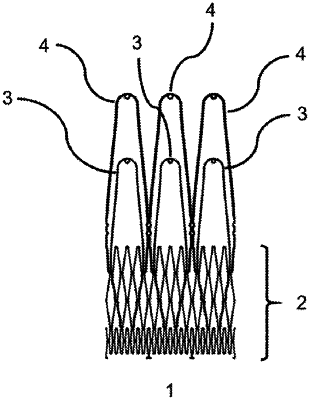| CPC A61F 2/2418 (2013.01) [A61F 2210/0004 (2013.01); A61F 2210/0014 (2013.01); A61F 2220/0008 (2013.01); A61F 2250/0048 (2013.01); A61F 2250/0067 (2013.01)] | 20 Claims |

|
1. An anchoring for a heart valve prosthesis for one of treatment, prevention, and replacement of a heart valve, in particular one of an inflamed, infected, thrombosed, and degenerated heart valve, the anchoring comprising:
a stent framework configured for attaching at least two heart valve leaflets to an inner side, wherein the stent framework has a proximal end and a distal end; and
at least two compartmentalization clips, each one of the at least two compartmentalization clips being connected with the stent framework at a first end region and having a free second end region, wherein the anchoring exhibits a primary form and is able to be reversibly transformed into a delivery form for minimally invasive introduction of the anchoring into a body of a patient by at least one of elastic deformation and compression of at least one of regions and elements of the anchoring,
wherein the compartmentalization clips are arcuately shaped between the first and second end regions in the primary form of the anchoring,
wherein the compartmentalization clips are configured to be elastically folded over such that the compartmentalization clips extend in a substantially flat manner between the first and second end regions in the delivery form of the anchoring,
wherein the anchoring further comprises a separation structure connected with the stent framework and the compartmentalization clips such that the separation structure separates areas of native heart valve leaflets to be treated from a bloodstream when the anchoring is in an implanted state,
wherein the compartmentalization clips comprise arms having an at least partial twisting in the primary form of the anchoring,
wherein the compartmentalization clips include a first clip surface and a second clip surface oppositely disposed from the first clip surface, and
wherein the first clip surface at the free second end area of the compartmentalization clips is directed substantially radially inward toward a longitudinal axis of the anchoring, in both the primary and delivery forms of the anchoring.
|